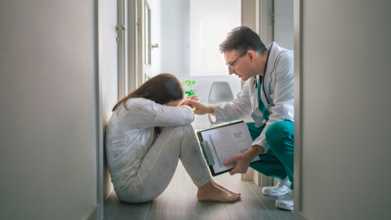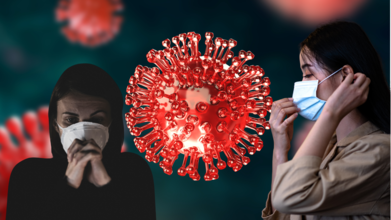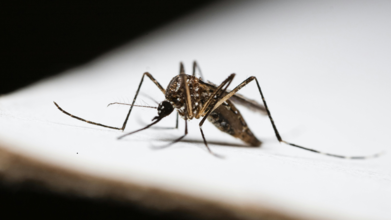- Health Conditions A-Z
- Health & Wellness
- Nutrition
- Fitness
- Health News
- Ayurveda
- Videos
- Medicine A-Z
- Parenting
- Web Stories
Illinois Becomes 1st State To Mandate Mental Health Screening For Students – Investing In The Future Of US

(Credit-Canva)
Starting in the 2027-2028 school year, public school students in Illinois will be required to have a mental health screening every year. This applies to all students from grades 3 through 12. The new law, signed by Governor JB Pritzker, makes Illinois the first state to require these screenings for all students. This move is a direct response to growing concerns about the mental well-being of children and teenagers.
What Steps Is The Government Taking For Student Well-Being?
Governor Pritzker explained that the new law is a step toward a more complete system for supporting young people's mental health. He noted that with more children struggling with anxiety and depression, it's important to make sure they get the help they need. The law will give schools the necessary support and resources to implement the screenings.
It also suggests that schools point parents and guardians toward the BEACON Portal, a special online tool that helps families find mental health resources and services in their area. This portal was launched in January and is meant to make it easier for people to get information about care.
What is Mental Health Screening?
School mental health screening is a process that uses a special tool or survey to check on the emotional and social well-being of all students. Unlike a typical check-up for a specific problem, these screenings are for everyone in a school or a certain grade level. The goal is to identify students' strengths and needs early on so they can get help before a small issue becomes a big problem. Screenings can also ask students about their life satisfaction, their sense of belonging at school, and any challenges they might be facing at home, such as food or housing insecurity.
Why Are Mental Health Screenings Necessary In Schools?
The decision by Illinois comes at a time when there's been a lot of national discussion about student mental health. Just two months before the bill was signed, the Trump administration cut funding for about $1 billion in mental health grants for schools. The Department of Education said the money was being used for "race-based actions" rather than for mental health services.
This has created a new challenge for schools across the country. Meanwhile, national health organizations like the Centers for Disease Control and Prevention (CDC) have highlighted the seriousness of the issue, reporting that anxiety and depression are very common in children aged 3 to 17, and are a particular problem for teenagers.
How Screening Helps Schools and Students
Mental health screening can benefit students and schools in many ways:
Identifies High-Need Students
Screenings help find students who need immediate support, such as those at risk of self-harm. This allows schools to quickly connect students with the right help and ensures that anyone in danger receives an immediate safety assessment.
Helps a Whole Classroom
Screening data can show if many students in one grade or class have similar needs. This lets a school provide support to the entire group at once, which saves time and makes sure more students get the help they need.
Informs School-Wide Programs
About 20% of students have signs of a mental health disorder each year, but screening can help all students. If screenings show high stress levels, a school can teach coping skills to the entire student body to prevent problems from getting worse.
Improves Access to Care
Many families face barriers to getting mental healthcare. With over 70% of mental health services for youth provided in schools, screenings can help all students access care, which leads to better grades and higher graduation rates.
Looks at the Whole Picture
Screenings don't just look for problems; they also ask about positive feelings like happiness. This gives schools a complete view of a student's well-being and helps reduce the stigma of talking about mental health.
‘Lucky To Be Alive', US Woman Wakes Up Just Seconds Before Doctors Begin Organ Harvesting

Credits: Canva (representational)
In a case that raises urgent ethical, medical, and systemic questions, a woman in New Mexico, US narrowly escaped having her organs harvested while she was still ALIVE. Her case exposes disturbing gaps in the US organ donation system and has sparked a nationwide debate about the protocols followed when a patient is declared beyond recovery.
Danella Gallegos, 38, was homeless when she suffered a still-unnamed medical crisis in 2022. She fell into a coma and was admitted to Presbyterian Hospital in Albuquerque, New Mexico. There, doctors told her family that her condition was irreversible and that she would never regain consciousness.
With no apparent hope left, the family made the heartbreaking decision to donate her organs to help others in need. In stepped New Mexico Donor Services, the organ procurement organization (OPO) designated to coordinate the logistics of organ harvesting but in the days leading up to the planned surgery, something didn’t feel right to Gallegos’ family.
According to her family, Danella showed subtle but unmistakable signs of life. Her sisters said they noticed tears running down her cheeks — a deeply human response. When they brought this to the donation coordinator's attention, they were told it was nothing more than a reflex.
On the day of the scheduled operation, one of her sisters claimed she felt Danella move when she held her hand. That alone should have raised immediate red flags. But the real shock came when medical staff observed Gallegos blinking in response to verbal commands — an act that clearly suggested consciousness and awareness.
Despite these signs, the organ donation coordinator present in the operating room allegedly encouraged doctors to go forward with the procedure, recommending they administer morphine and complete the surgery.
Against pressure from the donation organization, the physicians canceled the operation. That move saved Danella Gallegos’ life. In time, she emerged from her coma and ultimately made a full recovery.
Speaking after the ordeal, Gallegos admitted she felt fear while in the coma but has only patchy memories of the experience. “I feel so fortunate,” she said. “But it’s also crazy to think how close things came to ending differently.”
In response to growing scrutiny, New Mexico Donor Services denied any wrongdoing. The organization claimed it does not interfere in clinical decision-making and emphasized that only hospitals are responsible for patient care.
Presbyterian Hospital, however, painted a different picture. They asserted that New Mexico Donor Services oversees “all aspects” of the donation process. The hospital has since launched an investigation into Gallegos’s case.
Neva Williams, a veteran intensive care nurse at the hospital, offered a chilling summary to The New York Times: “All they care about is getting organs. They’re so aggressive. It’s sickening.”
This back-and-forth has laid bare the uncomfortable tension between medical ethics and the demand for transplantable organs. Here’s where it gets complicated, more than 103,000 people in the U.S. are currently on organ transplant waiting lists. Every day, approximately 13 people die waiting.
Organ procurement organizations exist to speed up the donation process and match recipients with available organs. Each donor can potentially save up to eight lives and improve 75 more through tissue and corneal donations.
Because viable organs have a very short shelf life after death, timing is everything. That urgency can create pressure — sometimes overwhelming — on hospitals and families.
The most ethically thorny donations happen under the classification of donation after circulatory death (DCD). Unlike brain death, where all brain activity has irreversibly ceased, patients in a DCD state may still have limited brain function and are typically removed from life support before organ removal begins. Doctors must wait until the heart has stopped beating for at least five minutes before they can begin the transplant process — otherwise, the organ is no longer viable.
In 2024, these DCD cases made up about one-third of all organ donations, according to government data.
What Are The Organ Donation Ethics Globally?
The United Kingdom uses an opt-out system for organ donation — meaning adults are presumed to be donors unless they explicitly say otherwise. Still, the legal framework places strong emphasis on confirming death through strict medical criteria before any organs are taken. Two main types of death are recognized:
- Circulatory death, where the heart stops beating for five continuous minutes.
- Brain stem death, which ensures the individual will never regain consciousness or breathe independently.
Importantly, in the UK, donation coordinators are strictly barred from intervening in any decisions related to life support withdrawal or patient care.
Danella Gallegos’ case has reignited an uncomfortable but necessary conversation: How much pressure is too much? When is a patient truly beyond recovery and who gets to decide? It also casts a spotlight on the increasing corporatization of organ donation, where nonprofits are under growing pressure to deliver results — often quantified in organ procurement rates — not human stories.
As the U.S. continues to rely heavily on OPOs to bridge the gap between donors and recipients, oversight and ethical accountability remain patchy at best.
While most organ donation cases proceed ethically and save countless lives, the outliers like Gallegos remind us that getting it wrong isn’t just a procedural misstep. It’s a near-death experience. For now, Gallegos is alive and healing but her experience stands as a stark reminder of what’s at stake when assumptions are made about comatose patients and when time-sensitive procedures begin to edge into dangerous ethical territory.
As hospitals and OPOs continue to work in high-pressure environments, there’s a pressing need for standardized safeguards, better oversight, and a renewed focus on what should always be the top priority, the living patient’s right to be heard, even in silence.
Can You Take Antibiotics For Covid-19? Here Is What The WHO Says Now

Back in 2020, the world went on an involuntary vacation. Borders shut, masks went up, and hand sanitiser became the new perfume. Fast forward five years, and Covid-19 is still lurking about and as the virus continues with newer variants like Stratus, currently rising in the US, a familiar question keeps popping up: Can I take antibiotics for Covid? The World Health Organization (WHO) has an answer.
New WHO Guidelines Say “No” to Unnecessary Antibiotics
The WHO has made it clear that antibiotics are not your Covid cure. Even if you are lying in bed with a fever, unless there is actual proof of a bacterial infection, antibiotics should not be part of your recovery plan. According to the updated guidance, even patients with severe Covid-19 should not be given antibiotics by default. The only exception is when there is genuine clinical suspicion of a concurrent bacterial infection. Otherwise, it is a waste and potentially harmful.“For patients with non-severe COVID-19 and a low clinical suspicion of a concurrent bacterial infection, we recommend no empirical antibiotics,” the WHO said.
Why This Change Now?
When Covid-19 first hit the world, doctors prescribed a lot of medicines, including antibiotics. But over time, researchers have wondered if all those pills are doing anything. A recent meta-analysis reviewed patient outcomes and found that antibiotics did not make a difference in people who did not have a bacterial infection.But this is not just about ineffective treatment. It is about antimicrobial resistance.
What Happens When There is Antibiotic Overuse?
When we misuse antibiotics, meaning taking them when we do not need to or not finishing a proper course, we help bacteria evolve into superbugs. These resistant bacteria are tough and do not cure with your average antibiotics. Antimicrobial resistance is already a global health crisis. By needlessly tossing antibiotics at Covid-19, we are just speeding up the problem.What Should You Do If You Get Covid Now?
If you test positive and your symptoms are mild, your best bet is rest, fluids, paracetamol for fever, and patience. Pop the antibiotics only when your doctor prescribes. Also, Covid is now handled like any other respiratory illness. That is why WHO has also scrapped older Covid-specific guidelines that no longer apply to the post-pandemic world.“Notable changes to COVID-19 disease over this time have been overall reduced infection rates and reduced disease severity,” the WHO said, adding that "Care for patients with COVID-19 has become more integrated with usual healthcare systems.”
In a nutshell, you cannot take antibiotics for Covid unless you also have a bacterial infection. And that is for a healthcare professional to decide. The WHO wants everyone, from doctors and pharmacists to patients and panic-buyers, to get on the same page. Antibiotics are powerful tools, and using them wisely could literally save the world.
However, the global health body warned that the virus continues to evolve in terms of infectivity, immune escape, and disease severity. “This guideline robustly and transparently addresses the changing landscape and
evidence availability, and the continual development of treatment and management strategies for Covid-19,” the WHO added.
West Nile Virus Detected In Mosquito Samples From Chatham-Kent

Credits: Canva
Chatham-Kent, a single-tier municipality in the Southwestern Ontario, Canada collected and trapped mosquitoes on July 30 from a trap in Ridgetown have been tested. The results are confirmed by the CK Public Health, confirming the mosquitoes positive for West Nile Virus.
What Is West Nile Virus?
As per the Centers for Disease Control and Prevention (CDC), West Nile virus is the leafing cause of mosquito-borne diseases. It is most commonly spread to people by the bite of an infected mosquito. Cases of West Nile occur during the mosquito season, which starts in the summer and continues through fall.
As of now, there are no vaccines to prevent or medicines to treat West Nile in people, notes CDC. The good thing? Most people infected with West Nile virus do not feel sick. About 1 in 5 people who are infected develop a fever and other symptoms. About 1 in 150 infected people develop a serious, or fatal illness. The best way to deal with this is by preventing mosquito bites.
Also Read: What is Glioma? Walking Dead Actress Kelly Mack Dies at 33 After Battling Rare Brain Cancer
The virus belongs to a group of viruses called flaviviruses. St Louis encephalitis virus and Powassan virus are the two other flavivirus that are also circulated in the Americas.
How Does It Spread?
West Nile virus circulates in the environment between mosquitoes, and the species is called Culex. It also circulates via birds. People become infected when the mosquitoes feed on infected birds and then bite people. The CDC says that people are dead-end hosts, because unlike birds, they do not develop high enough levels of virus in their bloodstream and cannot pass the virus on to other biting mosquitoes.
The virus is rarely transmitted from person-to-person by blood transfusion, organ transplantation, and mother to baby, during pregnancy, delivery, or breastfeeding. Because the virus can be transmitted through blood and organ transplantation, persons who were recently diagnosed with West Nile virus infection should not donate blood or bone marrow for 120 days following infection.
Birds And West Nile
The virus is transmitted to birds through the bite of an infected mosquito. The mosquitoes who become infected are through biting infected birds. Some birds that are predators like hawks and owls or scavengers like crows may become infected after eating sick or dead birds that were already infected by the virus. If birds eat infected mosquitoes then they too could become infected. Although some infected birds, especially crows and jays, frequently die of infection, most birds survive.
The CDC notes that there is no evidence that a person can get infected from handling live or dead infected birds. However, you should avoid bare-handed contact when handling any dead animal. If you must pick up a dead bird, use gloves or an inverted plastic bag to place the bird in a garbage bag.
What Happens If A Person Is Infected By West Nile Virus?
While most people have no symptoms, some may develop the following symptoms:
- Fever
- Headache
- Body Ache
- Fatigue
- Stiff Neck
- Nausea
- Difficulty Swallowing
- Vomiting
- Paralysis
Anyone with such severe symptoms must seek medical attention. For infants and older individuals, the risk is even more, as their immune systems are compromised.
The CK Publik health has urged residents to protect themselves from the virus by:
- Wearing light-coloured clothing, including long-sleeved shirts, long pants and socks.
- Using insect repellent containing DEET or Icaridin.
- Staying indoors from dusk to dawn, when mosquitoes are most active.
- Ensuring that all door and window screens are tight and free of holes.
- Eliminating sources of standing water to prevent mosquito breeding.
© 2024 Bennett, Coleman & Company Limited

